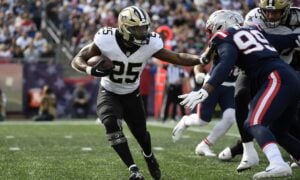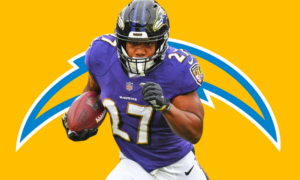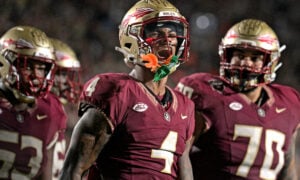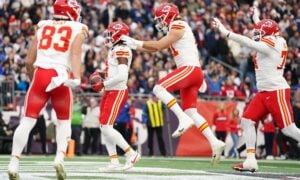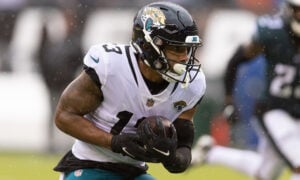Wide Receivers on New Teams
The current era of the NFL is watching players switch teams at a faster rate than ever before, especially at the wide receiver position. Since 2000, there have been 704 instances of a wide receiver switching teams. Of those 704 instances, 378 occurred since 2010 (53.6%) and 153 occurred since 2016 (21.7%).
While this recent uptick in player movement is fun for fans and fantasy players, it can be a headache for actual fantasy production. I did some preliminary research on this subject last year, which led me to endorse Allen Robinson in 2019 in his second season with Chicago.
As we enter the 2020 off-season, I’m writing to update and expand upon this topic, and to look ahead to wide receivers who could be a value this year like Robinson was last year.
Method and Data
I have heard from various sources that wide receivers have a tendency to underperform in their first season with a new team compared to their usual production on their former team. A recent example of this would be Jarvis Landry, who signed with the Cleveland Browns in 2018 and saw a decrease in production across the board, including a 41-point drop in fantasy points.
To study this effect, I pulled a list of 704 receivers since 2000 who switched teams. I compared production with their former team the year before they switched teams against production on their new team the year of the switch.
To account for the difference in games played from one season to the next, I used game averages for year-to-year comparisons.
I finished by filtering out all players who did not 1) play at least 12 games in either season, and 2) have at least 4 targets per game (league average) the year before they switched. This gave us a final data set of 184 receivers.
Here is the Landry example with data from his final year in Miami and his first year in Cleveland:

Results
The results of the study validate the theory that receivers tend to underperform in their first season on a new team. Shown below are four charts that show the averages of each receiving stat for all players in the data set the year before and the year after they switched teams:




As you can see, every orange bar (first season on a new team) is below the corresponding blue bars (last season on former team).
The two stats that really struck me first were the differences in targets per game and fantasy points per game. A decrease of 1.17 targets per game is a sizable difference of almost 20 targets over 16 games.
With that decrease, it’s very natural to see the decrease in receptions, yards, and touchdowns.
All of this culminates into a drop of 1.71 PPR fantasy points per game, a 27 point difference over 16 games. For reference, that is the difference between 2019 WR16 Mike Evans and 2019 WR25 Odell Beckham.
After looking at the numbers above, I decided to go one step further in my analysis. I filtered down the data set once more to show receivers who remained on their new team for a second season to see if there was improvement from year one to year two on the new team.
We can again use Landry as an example, who just finished his second season with Cleveland.
This filters our data set down to 91 instances of a player switching teams and playing two seasons with his new team. The results in this case are not too surprising, as shown in the charts below:




The charts above are the same as the previous ones, but now include the average stats for a player’s second season on his new team.
As you can see, every grey bar (second season on new team) is above every orange bar (first season on new team). This shows us that, on average, there is an improvement in year two for receivers on new teams. We can see that the average fantasy points per game increase in year two on a new team by 0.64 points, or just over 10 points over 16 games. While this is not a huge increase, it is the difference between 2019 WR30 DK Metcalf and 2019 WR34 Cole Beasley.
Another thing you might notice is none of the grey bars return to the value of the blue bars (last season on former team). This might lead us to believe that when a player switches teams, his production may never return to that of his former team.
Interpretation
There is a lot to be taken from the results above, and there are many factors that are contributing to receivers performing worse in year one with a new team. This could include everything that comes with learning a new offense, creating a rapport with a new quarterback, learning the nuances of a new coach and offensive coordinator, chemistry with new teammates, and of course the off-field factors like moving to a new city, relocating a family, etc.
Changing companies in our own lives has a transition period, and NFL players are no different.
One thing we can start doing with these results is applying them to receivers who were on new teams in 2019, or receivers who will be on new teams in 2020.
Since it’s only January and free agency hasn’t started, let’s look at a couple receivers who were on new teams in 2019 and look ahead to 2020.
Odell Beckham, WR CLE
Without a doubt the biggest name among receivers switching teams in 2019, Beckham’s 2019 campaign left much to be desired. Despite playing 16 games for the first time since 2016, Beckham produced his worst season statistically on a per-game basis.

There is still hope for a bounce back season in 2020. Of the 57 receivers who dropped in fantasy production in year one with a new team, 26 of them saw a bounce back season in year two. Another off-season to gain rapport with Baker Mayfield should bode well for Beckham in 2020. Coupled with the hiring of Kevin Stefanski as their new head coach, the Browns could be set up for a team bounce back after a disappointing 2019.
I will throw one more stat in here for reference to how bad Beckham’s 2019 really was. Of receivers who averaged over eight targets per game in the first year with a new team, only two receivers dropped in fantasy points harder than Beckham: Peerless Price (2002-2003) and Muhsin Muhammad (2004-2005). Price dropped in fantasy production another 20% in year two with his new team, and Muhammad essentially replicated his first season.
John Brown, WR BUF
Brown was one of five receivers on a new team in 2019 who outperformed his 2018 season statistically. (Coincidentally, his teammate Cole Beasley also outperformed his 2018 season).
Not only did Brown outproduce his 2018 season with Baltimore, 2019 was a career year for Smokey. He led the Bills in every receiving category as their de facto WR1 while becoming a consistent but still explosive fantasy receiver.
However, all good things must come to an end, or at least regress. Of the 184 receivers in our sample, only seven receivers saw a bigger bump in fantasy value by moving teams than Brown in 2019. The table below shows those seven receivers per game averages in year one and year two on a new team (sorted by targets per game in year one).
All seven receivers saw a drop in fantasy production by at least 2 points per game. This is actually an alarming drop in production for Brown. 32 fantasy points less in 2019 would have made him the WR34, just above Cole Beasley, instead of his actual finish of WR22.
Assuming the Bills offense remains the same heading into 2020, it’s hard for me to expect Brown to regress that hard. An addition to the receiving corps via free agency or the draft, or growth of a current receiving threat like Dawson Knox or Devin Singletary, could pull targets away from Brown. Assuming similar targets, however, would lead me to expect similar production to 2019.
Emmanuel Sanders, WR SF
Sanders is the final player I want to cover in this article because his 2020 situation is entirely up in the air.
In week eight, Sanders was traded from Denver to the 49ers for a third and fourth round pick. Overall, the move did not really affect his fantasy production, producing 10.96 points per game with San Francisco as opposed to 11.53 points per game with Denver. The reason his 2020 value is so open-ended currently is that he is set to become an unrestricted free agent this off-season. San Francisco is currently 27th in the league in 2020 cap space with only about $16 million in free budget to spend. While moves can be made to open cap space, it is entirely possible Sanders is not a 49er in 2020.
Even if Sanders returns for the 49ers, his fantasy value can swing in multiple directions. Since joining San Francisco in week eight, Sanders was out-targeted by George Kittle and Deebo Samuel. He was the epitome of a boom-bust receiver, with seven games (70%) finishing outside the top-48 receivers but also two games (20%) inside the top-6 (with one WR1 overall week).
It is possible Sanders climbs the target share ladder, but it’s unlikely he ever becomes the top target on the team. If he could find more consistency in his weekly production, he would be a much more digestible asset for fantasy players, but the odds are slim. With Samuel entering his second season after a promising rookie year, Kendrick Bourne stealing red-zone targets, a multitude of talented pass-catching running backs, and of course Kittle, it’s hard for me to believe Sanders becomes a viable weekly fantasy starter in San Francisco.
To add the cherry on top, Sanders might not even be a Niner in 2020, which will have us re-evaluating his fantasy value again on a new team. Assuming you read the first half of this article, it probably won’t be pretty.
- 11 Players to Buy in Dynasty Fantasy Football Leagues Right Now - February 24, 2024
- Dynasty Fantasy Football Waiver Wire: Week 18 - January 1, 2024
- Dynasty Fantasy Football Waiver Wire: Week 17 - December 25, 2023






